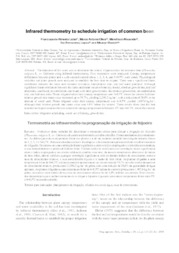Infrared thermometry to schedule irrigation of common bean.
Infrared thermometry to schedule irrigation of common bean.
Autoria: LOBO, F. A.; OLIVA, M. A.; RESENDE, M.; LOPES, N. F.; MAESTRI, M.
Resumo: ABSTRACT- The objective of this work was to determine the critical irrigation time for common bean (Phaseolus vulgaris L. cv. Carioca) using infrared thermometry. Five treatments were analyzed. Canopy temperature differences between plants and a well-watered control about 1, 2, 3, 4, and 5±0.5ºC were tested. Physiological variables and plant growth were analyzed to establish the best time to irrigate. There was a significant linear correlation between the index and stomatal resistance, transpiration rate, and leaf water potential. Although significant linear correlation between the index and mean values of total dry matter, absolute growth rate, and leaf area index was found, no correlation was found with other growth index like relative growth rate, net assimilation rate, and leaf area ratio. Plants irrigated when their canopy temperature was 3±0.5ºC above the control had their relative growth rate mean value increased up to 59.7%, yielding 2,260.2 kg ha-1, with a reduction of 38.0% in the amount of water used. Plants irrigated when their canopy temperature was 4±0.5ºC yielded 1,907.6 kg ha-1, although their relative growth rate mean value was 4.0% below the control. These results show that the best moment to irrigate common bean is when their canopy temperature is between 3ºC and 4±0.5ºC above the control. RESUMO-O objetivo deste trabalho foi determinar o momento crítico para efetuar a irrigação do feijoeiro (Phaseolus vulgaris L. cv. Carioca) utilizando a termometria ao infravermelho. Foram analisados cinco tratamentos. As diferenças entre a temperatura foliar das plantas e a de um controle mantido bem irrigado testadas foram de 1, 2, 3, 4 e 5±0,5ºC. Foram analisadas variáveis fisiológicas e de crescimento para identificar o melhor momento de irrigação. Encontrou-se uma correlação linear significativa entre o índice empregado e a resistência estomática, a taxa transpiratória e o potencial hídrico foliar. Embora tenha-se verificado uma correlação linear significativa entre o índice empregado e os valores médios da matéria seca total, da taxa de crescimento absoluto e do índice de área foliar, não se verificou qualquer correlação significativa com os demais índices de crescimento, como a taxa de crescimento relativo, a taxa assimilatória líquida e a razão de área foliar. As plantas irrigadas a uma temperatura foliar de 3±0,5ºC acima do controle apresentaram um incremento de 59,7% no valor médio da sua taxa de crescimento relativo, produzindo 2.260,2 kg ha-1 de grãos, com uma redução de 38,0% na quantidade de água aplicada. As plantas irrigadas a uma temperatura foliar de 4±0,5ºC acima do controle produziram 1.907,6 kg ha-1 de grãos, contudo o valor médio de sua taxa de crescimento relativo foi de 4,0% inferior ao controle. Estes resultados demonstram que o melhor momento de se irrigar o feijoeiro é quando apresentam temperatura foliar entre 3ºC e 4±0,5ºC acima do controle.
Ano de publicação: 2004
Tipo de publicação: Artigo de periódico
Unidade: Embrapa Milho e Sorgo
Observações
1 - Por padrão são exibidas publicações dos últimos 20 anos. Para encontrar publicações mais antigas, configure o filtro ano de publicação, colocando o ano a partir do qual você deseja encontrar publicações. O filtro está na coluna da esquerda na busca acima.
2 - Para ler algumas publicações da Embrapa (apenas as que estão em formato ePub), é necessário ter, no celular ou computador, um desses softwares gratuitos. Sistemas Android: Google Play Livros; IOS: iBooks; Windows e Linux: software Calibre.
Acesse outras publicações
Acesse a Base de Dados da Pesquisa Agropecuária (BDPA) para consultar o acervo completo das bibliotecas da Embrapa.

